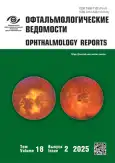Особенности клиники, диагностики и лечения глаукомы на фоне синдрома Стерджа–Вебера
- Авторы: Садовникова Н.Н.1, Бржеский В.В.1, Зерцалова М.А.1, Баранов А.Ю.1
-
Учреждения:
- Санкт-Петербургский государственный педиатрический медицинский университет
- Выпуск: Том 18, № 2 (2025)
- Страницы: 35-42
- Раздел: Оригинальные исследования
- Статья получена: 29.01.2025
- Статья одобрена: 24.02.2025
- Статья опубликована: 18.07.2025
- URL: https://journals.eco-vector.com/ov/article/view/648669
- DOI: https://doi.org/10.17816/OV648669
- EDN: https://elibrary.ru/ODQENI
- ID: 648669
Цитировать
Аннотация
Обоснование. Распространённость глаукомы при синдроме Стерджа–Вебера варьирует от 30 до 71%.
Цель — изучение клинических особенностей, результатов хирургического лечения глаукомы у детей с синдромом Стерджа–Вебера.
Материалы и методы. Проанализированы результаты лечения 34 пациентов (42 глаза) с глаукомой на фоне синдрома Стерджа–Вебера. Полученные данные включали: возраст, внутриглазное давление, переднезадний размер глазного яблока, диаметр роговицы, экскавацию диска зрительного норва, медикаментозное и хирургическое лечение.
Результаты. На момент манифестации глаукомы возраст пациентов составил 1,8±0,5 года, диаметр роговицы — 12,4±0,1 мм, что превысило возрастную норму на 22,1%. Размеры глазного яблока превышали возрастную норму на 17,5%. Медикаментозно глаукома стабилизирована на 13 глазах (31%). На 29 глазах выполнено 56 операций, в среднем 1,93 на глаз. Одного вмешательства для компенсации глаукомы было достаточно на 14 глазах (50%). При анализе гипотензивного эффекта проведенных вмешательств наиболее эффективной оказалась синустрабекулэктомия. Гипотензивный эффект сохранялся у 76,2% пациентов через 1 год, и у 50,7% — через 5 лет.
Заключение. Глаукома на фоне синдрома Стерджа–Вебера клинически протекает как первичная врождённая глаукома, манифестируя в 69% случаев у детей младше 1 года. Отмечается увеличение размеров роговицы и глазного яблока, в среднем на 22,1 и 17,4% соответственно. Хирургическое вмешательство требуется в 2/3 случаев. Наиболее эффективной операцией оказалась синустрабекулэктомия.
Ключевые слова
Полный текст
Об авторах
Наталия Николаевна Садовникова
Санкт-Петербургский государственный педиатрический медицинский университет
Автор, ответственный за переписку.
Email: natasha.sadov@mail.ru
ORCID iD: 0000-0002-8217-4594
SPIN-код: 4537-9231
канд. мед. наук
Россия, Санкт-ПетербургВладимир Всеволодович Бржеский
Санкт-Петербургский государственный педиатрический медицинский университет
Email: vvbrzh@yandex.ru
ORCID iD: 0000-0001-7361-0270
SPIN-код: 5442-0989
д-р мед. наук
Россия, Санкт-ПетербургМарина Андреевна Зерцалова
Санкт-Петербургский государственный педиатрический медицинский университет
Email: mazercalova@mail.ru
ORCID iD: 0000-0003-4559-0051
SPIN-код: 6493-7645
Россия, Санкт-Петербург
Андрей Юрьевич Баранов
Санкт-Петербургский государственный педиатрический медицинский университет
Email: homeandrey@rambler.ru
ORCID iD: 0000-0002-6024-4635
SPIN-код: 2345-3266
Россия, Санкт-Петербург
Список литературы
- All-Russian Public Organization “Association of Ophthalmologists”; All-Russian Public Organization “Society of Ophthalmologists of Russia”. Federal clinical recommendations “Congenital glaucoma”; 2024. (In Russ.)
- Weinreb RN, Grajewski A, Papadopoulos M, et al editors. 9th Consensus report of the World Glaucoma Association. Netherlands: Kugler Publications; 2013. 290 p.
- Schirmer R. Ein Fall von Teleangiektasie. Graefes Arch Ophthalmol. 1860;7:119–121. doi: 10.1007/BF02769257
- Sturge WA. A case of partial epilepsy, apparently due to a lesion of one of the vasomotor centres of the brain. Trans Clin Soc Lond. 1879;12:162–167.
- Sullivan TJ, Clarke MP, Morin JD. The ocular manifestations of the Sturge–Weber syndrome. J Pediatr Ophthalmol Strabismus. 1992;29(6): 349–356. doi: 10.3928/0191-3913-19921101-05
- Arora KS, Jefferys JL, Maul EA, Quigley HA. Choroidal thickness change after water drinking ıs greater in angle closure than in open angle eyes. Invest Ophthalmol Vis Sci. 2012;53(10):6393–6402. doi: 10.1167/iovs.12-10224
- Weiss DI. Dual origin of glaucoma in encephalotrigeminal haemangiomatosis. Trans Ophthalmol Soc UK. 1973;93:477–493.
- Sharan S, Swamy B, Taranath DA. Port-wine vascular malformations and glaucoma risk in Sturge–Weber syndrome. JAAPOS. 2009;13(4): 374–378. doi: 10.1016/j.jaapos.2009.04.007
- Maruyama I, Ohguro H, Nakazawa M. A case of acute angle-closure glaucoma secondary to posterior scleritis in patient with Sturge–Weber syndrome. Jpn J Ophthalmol. 2002;46(1):74–77. doi: 10.1016/s0021-5155(01)00463-4
- Cruciani F, Lorenzatti M, Nazzarro V, Abdolrahimzadeh S. Bilateral acute angle closure glaucoma and myopia induced by topiramate. Clin Ter. 2009;160(3):215–216.
- Mantelli F, Bruscolini A, La Cava M, et al. Ocular manifestations of Sturge–Weber syndrome: pathogenesis, diagnosis, and management. Clin Ophthalmol. 2016;10:871–878. doi: 10.2147/OPTH.S101963
- Cibis GW, Tripathi RC, Tripathi BJ. Glaucoma in Sturge–Weber syndrome. Ophthalmology. 1984;91(9):1061–1071. doi: 10.1016/s0161-6420(84)34194-x
- Keverline PO, Hiles DA. Trabeculectomy for adolescent onset glaucoma in Sturge–Weber syndrome. J Pediatr Ophthalmol. 1976;13(3):144–148. doi: 10.3928/0191-3913-19760501-08
- Kuznetsova YuD, Astasheva IB, Lesovoy SV, et al. Actics and results of surgical treatment for glaucomain children with Sturge–Weber syndrome. Modern technologies in ophthalmology. 2024;2(4):159–160. doi: 10.25276/2312-4911-2024-4-159-160 EDN: XFZBJK
- Sadovnikova NN, Brzheskiy VV, Zertsalova MA, Baranov AYu. The profile of childhood glaucoma — results of a 20-year retrospective study. National Journal glaucoma. 2023;22(2):71–80. doi: 10.53432/2078-4104-2023-22–2-71-80 EDN: XYQQBC
- Audren F, Abitbol O, Dureau P, et al. Non-penetrating deep sclerectomy for glaucoma associated with Sturge–Weber syndrome. Acta Ophthalmol Scand. 2006;84(5):656–660. doi: 10.1111/j.1600-0420.2006.00723.x
- Mandal AK. Primary combined trabeculotomy-trabeculectomy for early-onset glaucoma in Sturge–Weber syndrome. Ophthalmology. 1999;106(8):1621–1627. doi: 10.1016/S0161-6420(99)90462-1
- Board RJ, Shields MB. Combined trabeculotomy-trabeculectomy for the management of glaucoma associated with Sturge–Weber syndrome. Ophthalmic Surg. 1981;12(11):813–817. doi: 10.3928/1542-8877-19811101-06
- Amini H, Razeghinejad MR, Esfandiarpour B. Primary single-plate Molteno tube implantation for management of glaucoma in children-with Sturge–Weber syndrome. Int Ophthalmol. 2007;27:345–350. doi: 10.1007/s10792-007-9091-4
- Hamush NG, Coleman AL, Wilson MR. Ahmed glaucoma valve implant for management of glaucoma in Sturge–Weber syndrome. Am J Ophthalmol. 1999;128(6):758–760. doi: 10.1016/s0002-9394(99)00259-7
- Naranjo-Bonilla P, Giménez-Gómez R, Gallardo-Galera JM. Ex-Press implant in glaucoma and Sturge Weber syndrome. Arch Soc Esp Oftalmol. 2014;89(12):508–509. doi: 10.1016/j.oftal.2014.03.024
- Van Emelen C, Goethals M, Dralands L, Casteels I. Treatment of glaucoma in children with Sturge–Weber syndrome. J Pediatr Ophthalmol Strabismus. 2000;37(1):29–34. doi: 10.3928/0191-3913-20000101-08
- Caprioli J, Strang SL, Spaeth GL, Poryzees EH. Cyclocryotherapy in the treatment of advanced glaucoma. Ophthalmology. 1985;92(7):947–954. doi: 10.1016/s0161-6420(85)33951-9
- Brusakova EV, Ershova RV, Panchishena VM, et al. The modern approach to the visual examination of the angle of the anterior eye chamber in the children — iridocorneal goniography. Russian pediatric ophthalmology. 2012;7(2):7–11. doi: 10.17816/rpoj37417 EDN: PUHMKP
Дополнительные файлы










